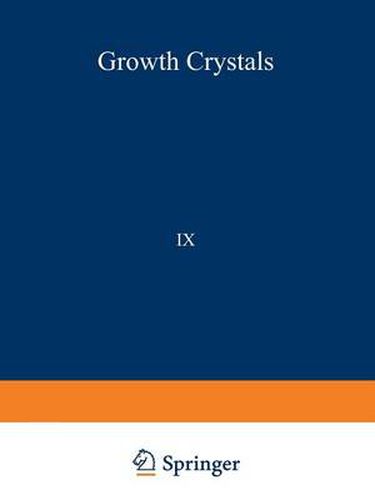Readings Newsletter
Become a Readings Member to make your shopping experience even easier.
Sign in or sign up for free!
You’re not far away from qualifying for FREE standard shipping within Australia
You’ve qualified for FREE standard shipping within Australia
The cart is loading…






This title is printed to order. This book may have been self-published. If so, we cannot guarantee the quality of the content. In the main most books will have gone through the editing process however some may not. We therefore suggest that you be aware of this before ordering this book. If in doubt check either the author or publisher’s details as we are unable to accept any returns unless they are faulty. Please contact us if you have any questions.
For 50 years the Fedorov Institute of Crystallography, Mineralogy, and Petrography at Leningrad Mining Institute has held annual memorial meetings for E. S. Fedorov. Immediate ly after the jubilee meeting (May 21-24, 1969), the Fedorov All-Union Symposium on Crystal Growth was held, and the proceedings of that symposium constitute Volume 9 of Growth of Crystals. The symposium surveyed the advances made in the USSR in those aspects of growth con cerned mainly with morphology and structure in natural crystals or closely related artificial ones, work which confirmed their relation to E. S. Fedorov and to mineralogical crystallogra phy. Crystallography is one of the older branches of natural science but has recently under gone a striking rejuvenation on account of new methods and new concepts. Photogoniometric methods have been developed in goniometry, while crystal optics has found new lines of ad vance in electrooptics and techniques in the ultraviolet and far infrared regions. Morphologic studies now use a vast range of techniques, from the hand lens to the electron microscope or cinemicrography. X-ray analysis is steadily becoming more automatic, and fast computers are used with accelerated methods of structure interpretation. Crystal growth is one of the younger divisions of crystallography; previously t it had been of interest only in experimental mineralogy, but now it is an important branch of science and technology with close relations to industry.
$9.00 standard shipping within Australia
FREE standard shipping within Australia for orders over $100.00
Express & International shipping calculated at checkout
This title is printed to order. This book may have been self-published. If so, we cannot guarantee the quality of the content. In the main most books will have gone through the editing process however some may not. We therefore suggest that you be aware of this before ordering this book. If in doubt check either the author or publisher’s details as we are unable to accept any returns unless they are faulty. Please contact us if you have any questions.
For 50 years the Fedorov Institute of Crystallography, Mineralogy, and Petrography at Leningrad Mining Institute has held annual memorial meetings for E. S. Fedorov. Immediate ly after the jubilee meeting (May 21-24, 1969), the Fedorov All-Union Symposium on Crystal Growth was held, and the proceedings of that symposium constitute Volume 9 of Growth of Crystals. The symposium surveyed the advances made in the USSR in those aspects of growth con cerned mainly with morphology and structure in natural crystals or closely related artificial ones, work which confirmed their relation to E. S. Fedorov and to mineralogical crystallogra phy. Crystallography is one of the older branches of natural science but has recently under gone a striking rejuvenation on account of new methods and new concepts. Photogoniometric methods have been developed in goniometry, while crystal optics has found new lines of ad vance in electrooptics and techniques in the ultraviolet and far infrared regions. Morphologic studies now use a vast range of techniques, from the hand lens to the electron microscope or cinemicrography. X-ray analysis is steadily becoming more automatic, and fast computers are used with accelerated methods of structure interpretation. Crystal growth is one of the younger divisions of crystallography; previously t it had been of interest only in experimental mineralogy, but now it is an important branch of science and technology with close relations to industry.